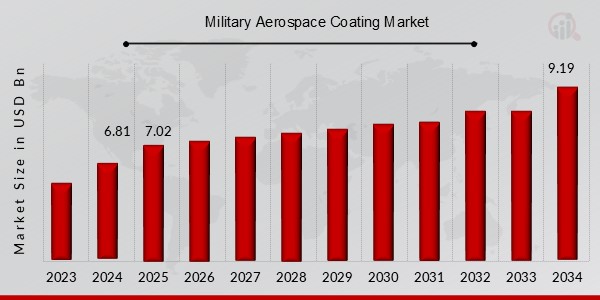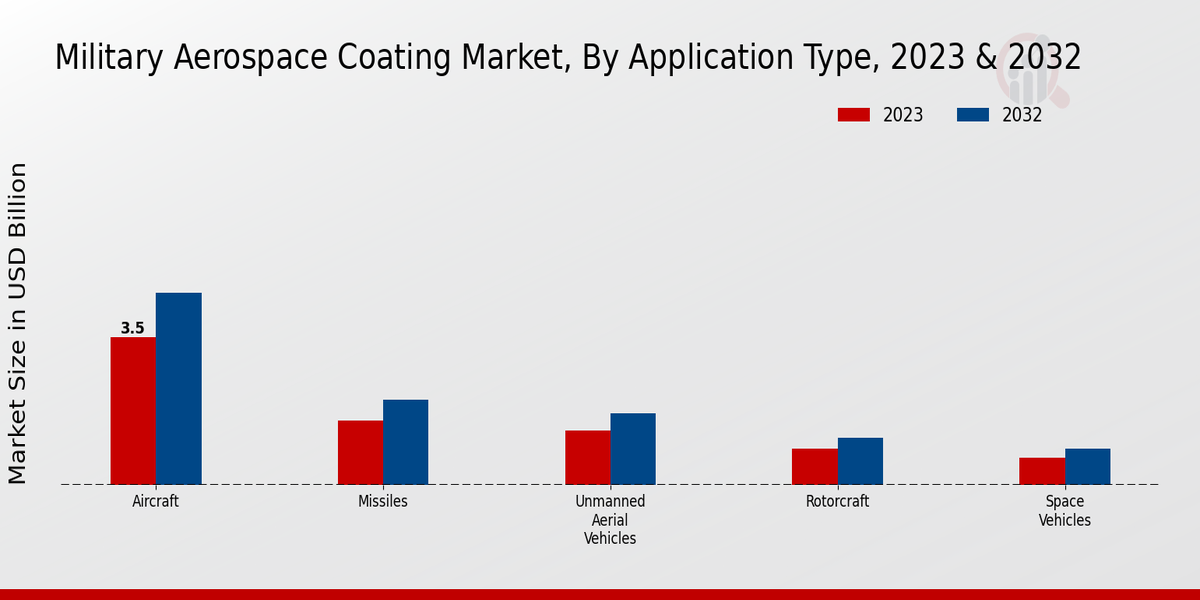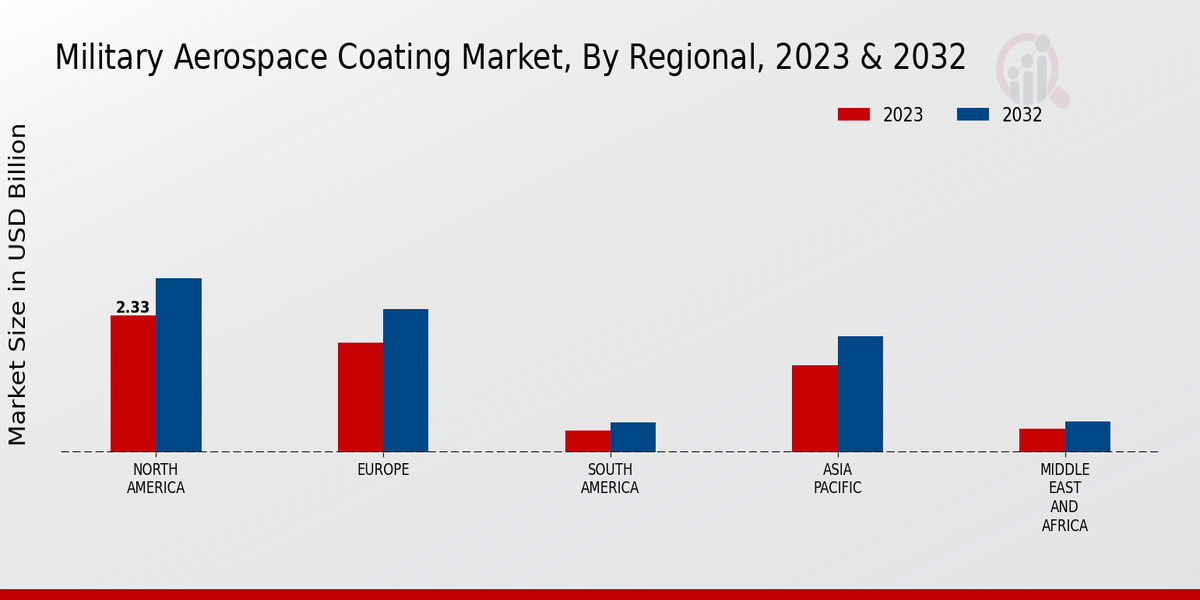Global Military Aerospace Coating Market Overview
The Military Aerospace Coating Market Size was estimated at 6.81 (USD Billion) in 2024. The Military Aerospace Coating Industry is expected to grow from 7.02 (USD Billion) in 2025 to 9.19 (USD Billion) by 2034. The Military Aerospace Coating Market CAGR (growth rate) is expected to be around 3.0% during the forecast period (2025 - 2034).
Key Military Aerospace Coating Market Trends Highlighted
The Military Aerospace Coating Market is driven by rising defense spending, technological advancements, and increased demand for lightweight and durable coatings. Key market drivers include the growing threat of corrosion and wear, the need for improved aircraft performance, and the adoption of advanced materials. Recent trends in the market include the development of nano-coatings, environmentally friendly coatings, and self-healing coatings. Opportunities to be explored include the integration of advanced sensors and electronics into coatings, the development of coatings for harsh environments, and the expansion of the market into new regions.

Source: Primary Research, Secondary Research, MRFR Database and Analyst Review
Military Aerospace Coating Market Drivers
Advanced Technologies Drive Innovation
The relentless pursuit of advanced technologies is a primary driver of growth in the Military Aerospace Coating Market Industry. Governments and defense organizations worldwide are investing heavily in research and development to enhance the capabilities and performance of their military assets. This, in turn, has led to a growing demand for specialized coatings that can withstand extreme conditions, improve stealth capabilities, and extend the lifespan of military equipment.Furthermore, ongoing advancements in materials science and nanotechnology are opening up new possibilities for developing coatings with enhanced properties, further fueling market expansion.
Geopolitical Tensions and Conflicts
Escalating geopolitical tensions and conflicts around the globe are creating an urgent need for robust and reliable military equipment. As nations seek to strengthen their defense capabilities, they are investing in the procurement, maintenance, and modernization of their military assets. This has resulted in increased demand for high-performance coatings that can protect aircraft, vehicles, and other military equipment from harsh environmental conditions, corrosion, and potential damage during combat operations.The ongoing conflicts in regions such as the Middle East, Eastern Europe, and Asia-Pacific are driving the demand for advanced coatings in the Military Aerospace Coating Market Industry.
Heightened Focus on Maintenance and Overhaul
Recognizing the importance of maintaining and extending the lifespan of existing military assets, governments and defense organizations are placing greater emphasis on maintenance, repair, and overhaul (MRO) activities. Regular maintenance and timely application of protective coatings are crucial to ensure the operational readiness and longevity of military equipment. This has led to a growing demand for specialized coatings that can withstand the rigors of military operations and harsh environments.The focus on MRO activities is expected to remain a key driver of growth in the Military Aerospace Coating Market Industry in the coming years.
Military Aerospace Coating Market Segment Insights:
Military Aerospae Coating Market Application Type Insights
The Military Aerospace Coating Market is segmented by Application Type into Aircraft, Missiles, Unmanned Aerial Vehicles (UAVs), Rotorcraft, and Space Vehicles. The Aircraft segment held the largest market share in 2023 and is projected to continue its dominance throughout the forecast period. The growth of this segment can be attributed to the increasing demand for advanced and durable coatings for aircraft to enhance their performance and extend their lifespan. The Missiles segment is expected to witness significant growth in the coming years due to the rising demand for advanced missile systems with improved capabilities.Coatings play a vital role in protecting missiles from corrosion, wear, and extreme temperatures. The Unmanned Aerial Vehicles (UAVs) segment is anticipated to grow at a steady pace, driven by the increasing adoption of UAVs for various military applications, including surveillance, reconnaissance, and combat. Coatings help enhance the stealth capabilities of UAVs and protect them from environmental factors. The Rotorcraft segment is projected to show moderate growth over the forecast period. Coatings are used on rotorcraft to improve their durability and resistance to corrosion and wear.The Space Vehicles segment is expected to witness a rise in demand due to the growing focus on space exploration and the development of advanced spacecraft. Coatings are essential for protecting space vehicles from the harsh conditions of outer space, including radiation and extreme temperatures. Overall, the Military Aerospace Coating Market is poised for steady growth in the coming years, driven by the increasing demand for advanced and durable coatings for military aircraft, missiles, UAVs, rotorcraft, and space vehicles.

Source: Primary Research, Secondary Research, MRFR Database and Analyst Review
Military Aerospace Coating Market Coating Function Insights
The Military Aerospace Coating Market segmentation by Coating Function comprises Corrosion Protection, Thermal Protection, Radiation Protection, Electromagnetic Interference (EMI) Shielding, and Stealth. Among these, Corrosion Protection held the largest market share of 38.4% in 2023 and is projected to continue its dominance throughout the forecast period. Corrosion Protection coatings protect metal surfaces from degradation caused by exposure to moisture, chemicals, and other environmental factors. The rising demand for aircraft and the increasing need for corrosion protection in harsh operating environments drive the growth of this segment.Thermal Protection coatings, with a market share of 27.6% in 2023, are designed to withstand extreme temperatures and prevent heat transfer. These coatings play a crucial role in protecting aircraft and spacecraft from heat generated by engines and aerodynamic friction. Radiation Protection coatings, Electromagnetic Interference (EMI) Shielding coatings, and Stealth coatings cater to specific requirements and account for the remaining market share.
Military Aerospace Coating Market Material Type Insights
The Military Aerospace Coating Market is segmented based on material type into metallic coatings, ceramic coatings, polymer coatings, hybrid coatings, and self-healing coatings. Metallic coatings held the largest market share in 2023 and are projected to continue their dominance throughout the forecast period. This is primarily due to their excellent mechanical properties, corrosion resistance, and high-temperature resistance. Ceramic coatings are expected to witness the fastest growth rate during the forecast period, owing to their superior properties such as hardness, wear resistance, and thermal insulation.Polymer coatings are widely used in military applications due to their lightweight, flexibility, and corrosion resistance. Hybrid coatings combine the properties of different materials, offering a unique combination of performance characteristics. Self-healing coatings are gaining popularity due to their ability to repair damage autonomously, increasing the lifespan of aerospace components.
Military Aerospace Coating Market Regional Insights
The Military Aerospace Coating Market is segmented into North America, Europe, APAC, South America, and MEA. Among these regions, North America is held the largest market share in 2023, owing to the presence of major aerospace and defense companies and the high demand for military aircraft, with a market value of 2.329 billion USD in 2023, increasing to 2.958 billion USD by 2032. Europe is expected to hold the second-largest market share, driven by the growing demand for military aircraft and the presence of major aerospace companies, with a market value of 1.864 billion USD in 2023, increasing to 2.44 billion USD by 2032. APAC is expected to witness the fastest growth rate during the forecast period, due to the increasing demand for military aircraft and the growing aerospace industry in the region, with a market value of 1.473 billion USD in 2023, increasing to 1.965 billion USD by 2032.South America and MEA are expected to hold a smaller market share, with South America valued at 0.363 billion USD in 2023, increasing to 0.511 billion USD by 2032, and MEA valued at 0.392 billion USD in 2023, increasing to 0.526 billion USD by 2032, but are expected to grow at a steady pace during the forecast period.

Source: Primary Research, Secondary Research, MRFR Database and Analyst Review
Military Aerospace Coating Market Key Players And Competitive Insights:
Major players in Military Aerospace Coating Market industry are constantly striving to gain a competitive edge by investing heavily in research and development. Leading Military Aerospace Coating Market players are focusing on developing innovative coating solutions that meet the evolving needs of the military and aerospace sectors. Merger and acquisition activities are also prevalent in the Military Aerospace Coating Market development landscape, as companies seek to expand their product portfolios and geographical reach. Key players are forming strategic partnerships and collaborations to strengthen their market position and gain access to new technologies and capabilities. The Military Aerospace Coating Market Competitive Landscape is highly competitive, with both established and emerging players vying for market share. Leading companies are investing in research and development, expanding their product portfolios, and strengthening their distribution networks to gain a competitive advantage.PPG is a leading supplier of coatings and specialty materials. Its Aerospace business unit provides a wide range of coatings for military and commercial aircraft, including corrosion-resistant coatings, thermal control coatings, and radar-absorbent coatings. PPG has a strong presence with manufacturing facilities in North America, Europe, and Asia. The company's commitment to innovation and customer service has helped it maintain a leading position in the Military Aerospace Coating Market.Sherwin-Williams is another major player in the Military Aerospace Coating Market. The company's Aerospace Coatings division offers a comprehensive range of coatings for military and commercial aircraft, including primers, topcoats, and specialty coatings. Sherwin-Williams has a strong focus on research and development, and its products are known for their durability, performance, and reliability. The company has a presence with manufacturing facilities in North America, Europe, and Asia. Sherwin-Williams' commitment to quality and customer service has helped it gain a strong reputation in the Military Aerospace Coating Market.
Key Companies in the Military Aerospace Coating Market Include:
- Safran
- Axalta Coating Systems
- Airbus SE
- Akzonobel
- L3Harris Technologies
- The Boeing Company
- Northrop Grumman
- Textron Inc.
- PPG Industries
- BAE Systems
- Lockheed Martin
- Raytheon Technologies
- Leonardo SpA
- Thales Group
Military Aerospace Coating Market Industry Developments
The market growth is primarily driven by increasing demand for advanced and durable coatings for military aircraft, rising investments in defense modernization programs, and growing adoption of lightweight and corrosion-resistant materials in aerospace applications. Additionally, the market is witnessing advancements in coating technologies, such as nanocoatings and self-healing coatings, which offer enhanced performance and extended lifespan of aerospace components. Recent news developments include Lockheed Martin's contract with Henkel to provide coatings for the F-35 fighter jets, and PPG's acquisition of the aerospace coatings business of AkzoNobel. These developments indicate a growing focus on developing and deploying high-performance coatings for military aerospace applications.
Military Aerospace Coating Market Segmentation Insights
- Military Aerospace Coating Market Application Type Outlook
- Aircraft
- Missiles
- Unmanned Aerial Vehicles (UAVs)
- Rotorcraft
- Space Vehicles
- Military Aerospace Coating Market Coating Function Outlook
- Corrosion Protection
- Thermal Protection
- Radiation Protection
- Electromagnetic Interference (EMI) Shielding
- Stealth
- Military Aerospace Coating Market Material Type Outlook
- Metallic Coatings
- Ceramic Coatings
- Polymer Coatings
- Hybrid Coatings
- Self-Healing Coatings
- Military Aerospace Coating Market Regional Outlook
- North America
- Europe
- South America
- Asia Pacific
- Middle East and Africa
| Report Attribute/Metric |
Details |
| Market Size 2024 |
6.81 (USD Billion) |
| Market Size 2025 |
7.02 (USD Billion) |
| Market Size 2034 |
9.19 (USD Billion) |
| Compound Annual Growth Rate (CAGR) |
3.0% (2025 - 2034) |
| Report Coverage |
Revenue Forecast, Competitive Landscape, Growth Factors, and Trends |
| Base Year |
2024 |
| Market Forecast Period |
2025 - 2034 |
| Historical Data |
2020 - 2024 |
| Market Forecast Units |
USD Billion |
| Key Companies Profiled |
Safran, Axalta Coating Systems, Airbus SE, Akzonobel, L3Harris Technologies, The Boeing Company, Northrop Grumman, Textron Inc., PPG Industries, BAE Systems, Lockheed Martin, Raytheon Technologies, Leonardo SpA, Thales Group |
| Segments Covered |
Application Type, Coating Function, Material Type, Regional |
| Key Market Opportunities |
Improved Corrosion Resistance Enhanced Durability Improved Stealth Capabilities Increased Fuel Efficiency Advanced Sensor Integration |
| Key Market Dynamics |
Increasing demand for stealth and durability Advancements in materials science Growing focus on reducing environmental impacts Rise of unmanned aerial vehicles Technological innovations |
| Countries Covered |
North America, Europe, APAC, South America, MEA |
Frequently Asked Questions (FAQ) :
The Military Aerospace Coating Market is projected to reach USD 9.19 billion by 2034, exhibiting a CAGR of 3.0% during the forecast period of 2025-2032.
North America is expected to dominate the Military Aerospace Coating Market throughout the forecast period due to the presence of major defense contractors and significant military spending.
Increasing demand for advanced coatings for aircraft and military vehicles, growing military budgets, and technological advancements are the primary growth drivers of the Military Aerospace Coating Market.
Military Aerospace Coatings are primarily used for corrosion protection, wear resistance, and stealth applications in aircraft, helicopters, missiles, and military vehicles.
Key competitors in the Military Aerospace Coating Market include PPG Industries, AkzoNobel, Axalta Coating Systems, Sherwin-Williams, and Mankiewicz Coatings.
The Asia-Pacific region is expected to witness a growth rate of 3.5% during the forecast period, primarily driven by increasing defense spending and the expansion of the aerospace industry in the region.
The demand for eco-friendly Military Aerospace Coatings is growing due to increasing environmental regulations and the need for sustainable solutions in the aerospace industry.
Advancements in nanotechnology, self-healing coatings, and anti-icing coatings are transforming the Military Aerospace Coating Market.
The growing adoption of UAVs is creating new opportunities for Military Aerospace Coatings due to the unique coating requirements of these vehicles.
Stringent environmental regulations, fluctuating raw material prices, and intense competition are the major challenges faced by the Military Aerospace Coating Market.
















